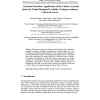Free Online Productivity Tools
i2Speak
i2Symbol
i2OCR
iTex2Img
iWeb2Print
iWeb2Shot
i2Type
iPdf2Split
iPdf2Merge
i2Bopomofo
i2Arabic
i2Style
i2Image
i2PDF
iLatex2Rtf
Sci2ools
HCI
2009
2009
Emotion Detection: Application of the Valence Arousal Space for Rapid Biological Usability Testing to Enhance Universal Access
Emotion is an important mental and physiological state, influencing cognition, perception, learning, communication, decision making, etc. It is considered as a definitive important aspect of user experience (UX), although at least well developed and most of all lacking experimental evidence. This paper deals with an application for emotion detection in usability testing of software. It describes the approach to utilize the valence arousal space for emotion modeling in a formal experiment. Our study revealed correlations between low performance and negative emotional states. Reliable emotion detection in usability tests will help to prevent negative emotions and attitudes in the final products. This can be a great advantage to enhance Universal Access.
| Added | 18 Feb 2011 |
| Updated | 18 Feb 2011 |
| Type | Journal |
| Year | 2009 |
| Where | HCI |
| Authors | Christian Stickel, Martin Ebner, Silke Steinbach-Nordmann, Gig Searle, Andreas Holzinger |
Comments (0)

